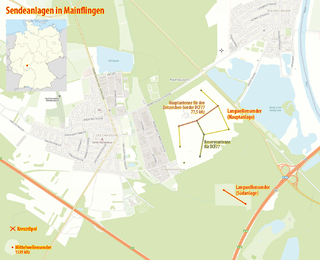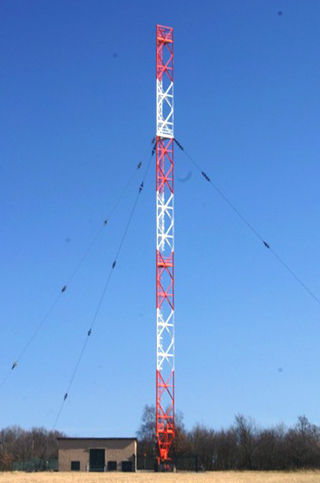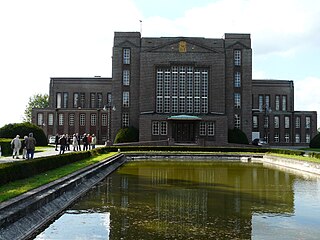The Experimental Radio Station Eberswalde was an experimental radio station of the company C. Lorenz AG founded in Eberswalde, Germany in 1909.
As an antenna system, it used an umbrella aerial, which was mounted on a 70-metre-high, guyed central mast and supported at the corners by sixteen 30-metre-high timber masts. The central mast was wood-latticed with a weight of 10.2 tons, guyed in 5 levels. As transmitters, arc and machine transmitters were used, which served mainly for the purpose of telegraphy.
Between January 1923 and January 1925, music transmissions were also done, although the station was never a regular broadcasting station. Starting in 1924, the station was used for short wave experiments. In 1928, the first experimental radio beacon was built on the Experimental Radio Station Eberswalde. It operated in the medium-wave band and used a triangle plane aerial, which was hung up on three 28 metre tall masts. Starting in the middle of the 1930s, the station was gradually shut down. In 1939, the entire antenna system including the central mast was dismantled. Starting in 1942, the buildings were used for a research centre for investigating the production of fuel from peat. From 1954 to 1963, the facilities served the forest-economy faculty of the Humboldt University of Berlin. The facilities are unused today.

Medium wave (MW) is the part of the medium frequency (MF) radio band used mainly for AM radio broadcasting. The spectrum provides about 120 channels with more limited sound quality than FM stations on the FM broadcast band. During the daytime, reception is usually limited to more local stations, though this is dependent on the signal conditions and quality of radio receiver used. Improved signal propagation at night allows the reception of much longer distance signals. This can cause increased interference because on most channels multiple transmitters operate simultaneously worldwide. In addition, amplitude modulation (AM) is often more prone to interference by various electronic devices, especially power supplies and computers. Strong transmitters cover larger areas than on the FM broadcast band but require more energy and longer antennas. Digital modes are possible but have not reached momentum yet.

A radio clock or radio-controlled clock (RCC), and often colloquially referred to as an "atomic clock", is a type of quartz clock or watch that is automatically synchronized to a time code transmitted by a radio transmitter connected to a time standard such as an atomic clock. Such a clock may be synchronized to the time sent by a single transmitter, such as many national or regional time transmitters, or may use the multiple transmitters used by satellite navigation systems such as Global Positioning System. Such systems may be used to automatically set clocks or for any purpose where accurate time is needed. Radio clocks may include any feature available for a clock, such as alarm function, display of ambient temperature and humidity, broadcast radio reception, etc.

Sender Zehlendorf or Zehlendorf (radio) transmission facility was a radio transmission facility which was in service since 1936, when a short wave transmitter was built on the occasion of the Berlin 1936 Summer Olympics in Zehlendorf as part of the establishment of permanent radio services. This Zehlendorf site, which until the end of World War II was referred to as the Rehmate Radio Transmission Centre, had 26 different antennas at the time.

The Mühlacker Broadcasting Transmission Facility is a radio transmission facility near Mühlacker, Germany, first put into service on November 21, 1930. It uses two guyed steel tube masts as aerials and one guyed steel framework mast, which are insulated against ground. It has two transmission aerials for shortwave and one free standing steel framework tower for directional radio services. The shortwave transmitter was shut off on October 19, 2004. The medium wave transmitter was switched off in January 2012.

The AM transmitter in Burg, near Magdeburg, Germany, is a huge facility for longwave and mediumwave broadcasting. Its most dominant constructions are a 324-metre guyed radio mast and two 210 metre guyed steel tube masts.

The Langenberg transmission tower is a broadcasting station for ananlog FM Radio and Digital-TV signals. It is located in Langenberg, Velbert, Germany and owned and operated by Westdeutscher Rundfunk, WDR.

The Transmitter Ismaning was a large radio transmitting station near Ismaning, Bavaria, Germany. It was inaugurated in 1932. From 1932 to 1934 this transmitter used a T-antenna as transmitting antenna, which was spun between two 115-metre-high free-standing wooden lattice towers, which were 240 metres apart. As this antenna had an unfavourable vertical radiation pattern, which produced much skywave resulting in a too small fading-free reception area at night, in 1934 a new antenna was installed. Therefore, one of the towers was dismantled and rebuilt on a 39-metre-high (128 ft) wooden lattice base. While this work took place, an L-Antenna was used, which was spun between the other tower and a small auxiliary wooden tower. It became defunct in 1977 and was destroyed in 1983.

Transmitter Berlin-Britz was a broadcasting facility for medium wave, shortwave and FM on the site of a former tree nursery in Berlin-Britz. It was established in 1946 and until 1993 it was the most important transmitter of RIAS. It was used by Deutschlandradio until 4 September 2013, and was finally demolished on 18 July 2015.

The Mainflingen mediumwave transmitter is a mediumwave transmission facility south of the A3 motorway near Mainflingen, Hesse, Germany. Mainflingen was the first mediumwave transmitter for the radio station Deutschlandfunk. It went into service in 1962 with a transmission power of 50 kW, on a frequency of 1538 kHz, at the upper end of the mediumwave band. This frequency has a bad groundwave propagation and therefore a low range at daytime, but an excellent skywave propagation with a long range at night.

The Königs Wusterhausen transmitter was a large transmission facility for longwave, mediumwave and shortwave radio, located near Königs Wusterhausen southeast of Berlin, Germany. Initially built by the telegraph battalion of the German Army, operation began during World War I in 1916. On 22 December 1920, the transmission of a Christmas concert marked the birth of public broadcasting in Germany.
The mediumwave transmitter Flevoland was a broadcasting facility for medium wave near Zeewolde in the province of Flevoland, Netherlands, situated at 5°25′ E and 52°23′ N. It has been used for broadcasting on 747 kHz and 1008 kHz with a nominal power of 400 kilowatts. As aerial two guyed steel framework masts with a height of 195 metres are used, which form an anti-fading aerial. These masts are grounded and carry a cage aerial, which is upperward the separation insulator, separating the masts in a height of 95 metres in two parts, connected toward the mast construction. The radiation diagram is directional, with a maximum gain of 4 dB in South-Eastern direction, to compensate for the variation in electrical admittance of terrain in the Netherlands.
Radio masts and towers are typically tall structures designed to support antennas for telecommunications and broadcasting, including television. There are two main types: guyed and self-supporting structures. They are among the tallest human-made structures. Masts are often named after the broadcasting organizations that originally built them or currently use them.

Eilvese transmitter was an early long-distance radiotelegraphy station at Eilvese, Germany owned by Transradio AG, used for transmission of telegrams. It went into service in 1913, exchanging commercial and diplomatic Morse code traffic on VLF frequencies with Germany's colonies, and a similar station at Tuckerton, New Jersey, USA. During World War I when the allies cut Germany's submarine telegraph cables it was one of two long-distance radiotelegraphy stations which maintained Germany's contact with the rest of the world, and was used for diplomatic negotiations between Woodrow Wilson and Kaiser Wilhelm II leading to the 1918 Armistice which ended World War I.

An umbrella antenna is a capacitively top-loaded wire monopole antenna, consisting in most cases of a mast fed at the ground end, to which a number of radial wires are connected at the top, sloping downwards. They are used as transmitting antennas below 1 MHz, in the MF, LF and particularly the VLF bands, at frequencies sufficiently low that it is impractical or infeasible to build a full size quarter-wave monopole antenna. The outer end of each radial wire, sloping down from the top of the antenna, is connected by an insulator to a supporting rope or (usually) insulated cable anchored to the ground; the radial wires can also support the mast as guy wires. The radial wires make the antenna look like the wire frame of a giant umbrella hence the name.

Marnach transmitter was a broadcasting facility of RTL near Marnach in the commune of Clervaux, in northern Luxembourg. The Marnach transmitter was built in 1955 for improving the transmission of the English-speaking program on 1439 kHz, which was transmitted from 1951 with an omnidirectional antenna from Junglinster, to the British Isles and for a better transmission on this frequency to Germany at daytime. Therefore, it was given a directional antenna with a switchable directional characteristic pointing North-northeast towards the Rhine-Ruhr area, Germany's most populated area, and West-northwest in the direction of the UK. This antenna was implemented in form of a directional antenna consisting of three ground-fed 105-metre (350') tall guyed mast antennas arranged in the form of an isosceles triangle with a 90 degree angle. As transmitters, two 100 kW units switched in parallel were used when it went in service in December 1955.

Nauen Transmitter Station in Nauen, Havelland district, Brandenburg, Germany, is the oldest continuously operating radio transmitting installation in the world. Germany's first high power radio transmitter, it was founded on 1 April 1906 by Telefunken corporation and operated as a longwave radiotelegraphy station through World War II, and during World War I became Germany's main link with the outside world when its submarine communications cables were cut. Upgraded with shortwave transmitters in the 1920s it was Germany's most advanced long range radio station, continually upgraded with the latest equipment and serving as an experimental station for Telefunken to test new technology. At the end of World War II, invading Russian troops dismantled and removed the transmitting equipment. During the Cold War it served as the GDR's international shortwave station Radio Berlin International (RBI), and was the East Bloc's second most powerful radio station, disseminating Communist propaganda to other countries. Since German Reunification in 1991 it has been operated by Deutsche Telekom, Germany's state telecommunication service. The original 1920 transmitter building designed by architect Herman Muthesius is still used; it is the only remaining building designed by that architect.

Naval Radio Transmitter Facility Aguada is a tall guyed radio mast erected by the United States Navy. It is used as a facility of the US Navy for ashore and U.S. and NATO ships, planes, and submarines operating at sea in areas of broadcast coverage near Aguada, Puerto Rico at 18°23′55″N67°10′38″W by using radio waves in the very low frequency range.
C. Lorenz AG (1880–1958) was a German electrical and electronics firm primarily located in Berlin. It innovated, developed, and marketed products for electric lighting, telegraphy, telephony, radar, and radio. It was acquired by ITT in 1930 and became part of the newly founded company Standard Elektrik Lorenz (SEL) Stuttgart in 1958, when it merged with Standard Elektrizitätsgesellschaft and several other smaller companies owned by ITT. In 1987, SEL merged with the French companies Compagnie Générale d'Electricité and Alcatel to form the new Alcatel SEL.
Berlin-Köpenick transmitter was a transmission facility for broadcasting on medium wave, short wave, and VHF in Berlin-Köpenick, Germany, near the suburb of Uhlenhorst, after which it was occasionally named.